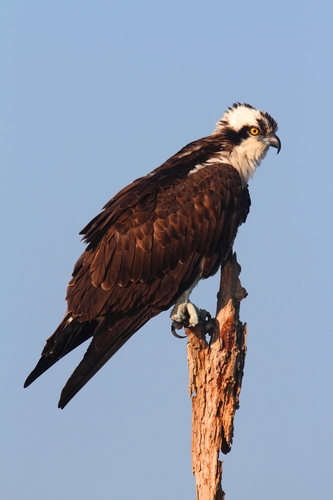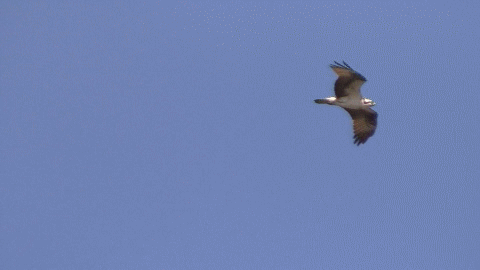
Written By: Sahil
The Osprey(Pandion haliaetus) is a diurnal (active during the day), fish eating bird of prey. it specializes in catching and eating fish. The Osprey’s diet consists primarily of fish, due to this, it is also known as sea hawk, river hawk and fish hawk. It is usually considered a medium-large raptor. Ospreys are sometimes confused with Bald Eagles, but ospreys are differentiated by their white underparts and their distinctive black eye stripe that continues to go on their faces. Because the Osprey is a species with many unique characteristics it has therefore been given its own taxonomic genus, Pandion, and family, Pandionidae.
Description
The Osprey is a medium-large sized raptor. It weighs between 0.9-2.1 kg (2.0-4.6 lbs.). Its body length is 50-66 cm with a wingspan of 127-180 cm. It has an appearance like a Bald Eagle. But the colors are different. Its head is white and has a black stripe which goes down the side of its face. The upperparts are a deep, glossy brown, while the breast is white and sometimes streaked with brown, and the underparts are pure white. The irises of the eyes are golden to brown, and the transparent nictitating membrane is pale blue. The bill is black, with a blue cere, and the feet are white with black talons. A short tail and long, narrow wings with four long, finger-like feathers, and a shorter fifth, give it a very distinctive appearance.
Habitat
The Osprey is one of the most widely distributed birds and is found all over the world. It is found on all continents except Antarctica, although in some parts of the world it occurs as a non-breeding migrant. breeding throughout much of North America, Northern Europe and Asia and around the coast of Australia. They are usually found near water bodies, with adequate food supply.
Diet
The Osprey is a unique raptor, standing out not only for its beauty but also for its choice of prey and their prey of choice is fish. They feed primarily on fish and have adapted very well to this. Though fish are by far the most important part of the diet, ospreys have been recorded catching a wide variety of other prey, including birds, reptiles and even crustaceans. The Osprey is particularly well adapted to this diet, with reversible outer toes, closable nostrils to keep out water during dives, and backwards facing scales on the talons which act as barbs to help hold its catch.
Ospreys hunt by diving to the water’s surface from some 30 to 100 feet up. They have gripping pads on their feet to help them pluck fish from the water with their curved claws and carry them for great distances. In flight, ospreys will orient the fish headfirst to ease wind resistance.
Reproduction
Ospreys breed near freshwater bodies and sometimes close to coastal areas. Ospreys make large nests on the top of dead or live trees. Ospreys will readily adopt artificial nest platforms, especially where there is a shortage of suitable trees in which to nest. Unlike most birds of prey, ospreys like to breed in loose colonies, and the presence of one successful pair will often attract others in following years. They reach sexual maturity and start breeding at 3-5 years. The male and female only remain together during the breeding period, most probably they breed together in the same aerie the next year. The female lay 3-4 eggs within a month. The incubation period is about 5 weeks. The hatchlings are very small, featherless and weighs only 50-60 g, but they fledge within 8-10 weeks of hatching. When the food is scarce, only the first chick is the one to survive. The typical lifespan of an osprey is 7-10 years but in some rare cases, individuals have been recorded to live 20-25 years.

Migration
Ospreys are migratory birds and they migrate during the winter. European breeders winter in Africa. Canadian and American breeders winter in south America. Australasian (Australia, and New Zealand) ospreys do not migrate. In the Mediterranean, Ospreys show partial migratory behavior with some individuals remaining resident, whilst others undertake relatively short migration trips.
